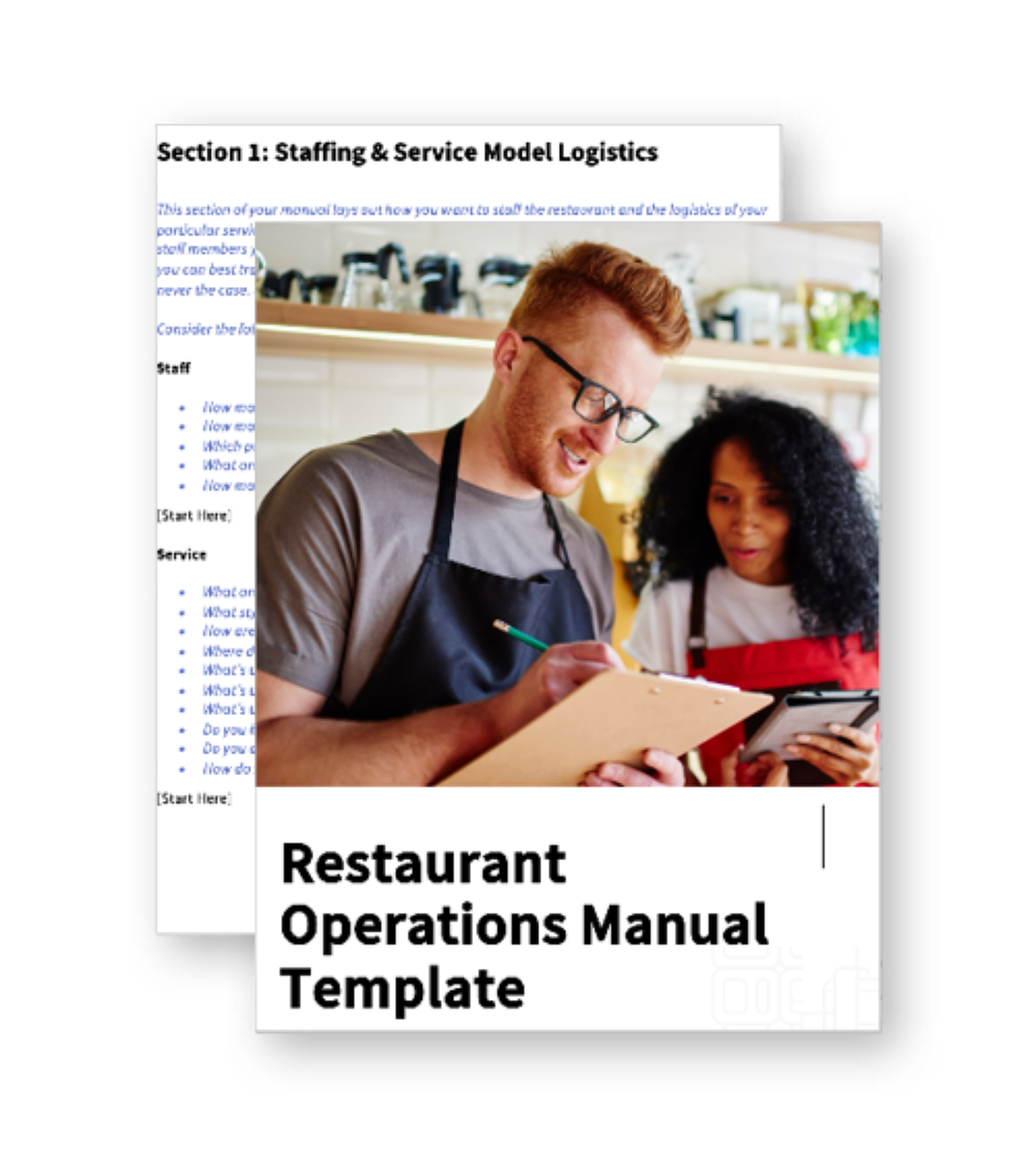
Your Guide To A Smooth Restaurant Shift Change, Every Time
Switching from AM to PM doesn’t have to be chaotic. Here’s how to build a smooth restaurant shift change.

Tessa ZuluagaAuthor


Restaurant Operations Manual Template
Use this free template to easily outline all of your operating procedures and make day-to-day operations as consistent as possible.
As the last mimosa is poured and the final brunch plates are cleared, a lot takes place behind the scenes. The transition from brunch to dinner service can be a disorderly time for any full-service restaurant. This shift change is a ritual of organized chaos for the commonly overworked staff. Servers dart around resetting tables while cooks switch the lines for dinner prep. The night crew comes in and needs to know the specials while the day crew is trying their best to cash out and exit the building. This is a common pain point for many restaurant establishments, but there are solutions.
In this article, we’re breaking down how to improve your restaurant shift change. From helpful tips to a checklist template, we’ve got you covered. Let’s get started.
Server Side Work Checklist Template
This Excel document template will help you create a Server Side Work Checklist for your restaurant — and train staff more effectively.

What is a restaurant shift change?
If you’re just starting out or call it something different in your restaurant, a shift change is the transition period when the day shift closes and the night shift begins. This can be a challenging time to navigate – the restaurant is often hectic and many tasks have to happen at once.
The staff that opened the restaurant and worked brunch have to finish all their side work and cash out before they can leave. Meanwhile, the night shift has to be informed about what’s happening at dinner service and start taking over tables. For the back-of-house, all ingredients and prep need to be switched. The eggs get put back in the walk-in and the line is prepared for the dinner menu.
Why are shift changes so important?
Proper coordination during shift changes is crucial to avoid service disruptions, ensure smooth hand-offs, and maintain efficiency. It requires teamwork between both front- and back-of-house staff.
Brunch to dinner isn’t just a change of menu—it’s a complete shift of environment, clientele, staff, and food. Brunch guests are wrapping up as dinner guests arrive, the kitchen is flipping, and the evening staff is on their way in. Because of this, it’s absolutely crucial to keep all staff members communicating with management, back of house, and each other. Solid communication ensures all moving parts work together seamlessly.
Amy Peppercorn
General Manager, Reyna Restaurant NYC
If your restaurant can perfect this process it can make a huge difference.
Some benefits of this smooth transition include:
Smoother operations: A well-executed shift change can prevent confusion, delays, or mistakes that could negatively impact the dining experience.
Better communication: Communication is essential for the new team to be fully informed and prepared to handle any pending tasks or challenges effectively.
Clearer responsibility: Tasks and duties are properly handed over, ensuring nothing falls through the cracks and that everyone understands their roles and responsibilities for the upcoming shift.
Improved time management: An efficient shift change prevents delays, overtime, and potential labor cost issues.
Lifted staff morale: A well-organized shift change demonstrates respect for each other's time and efforts, and can promote a collaborative environment where everyone is working towards a common goal. Setting each other up for success goes a long way.
Enhanced training: More experienced staff can share tips, best practices, and insights with newer team members, contributing to their professional development.
These benefits ultimately contribute to better customer satisfaction, employee retention, and overall productivity in the restaurant.
How to have a successful shift change
How can you make all of this happen? What’s the secret formula? It just takes time and organization to get this process running smoothly.
Consider following the steps below to implement a smoother, successful shift change between co-workers.
Schedule in-times strategically
It all begins with the work schedule. Proper employee scheduling can help make the shift change process smoother and more efficient. Here’s how to make the best schedule changes:
Stagger in times when possible: Instead of having all employees start their shifts at the same time, restaurants can stagger their in-times, depending on the timing of their covers. For example, some servers might start at 4 pm, while others start at 4:30 pm or 5 pm. This allows for a gradual transition during the shift change, rather than a sudden influx of new employees all at once.
Overlap with the previous shift: By scheduling some employees to start their shifts slightly earlier than others, there's an overlap period where employees from the previous shift and the new shift are both present. This overlap allows for better communication and knowledge transfer between shifts, ensuring that important information (like special requests, ongoing issues, etc.) is properly relayed.
Maintain service levels: During busier periods, restaurants can switch it up and schedule more employees to start their shifts earlier to ensure that service levels are maintained even during the shift change. This prevents a lull in service or long wait times for customers when one shift is leaving, and the next shift is just starting. This is all dependent on how many reservations are on the books and when they’re coming in.
Overall, if you schedule for the work day in accordance with how busy the restaurant is projected to be, you can prepare for the evening shift while letting the morning workers leave, all while saving on labor costs.
Restaurant Scheduling Template
Use the Restaurant Scheduling Template to easily schedule your restaurant staff's shifts.

Consider offering a limited menu
Offering a limited menu during shift changes can help restaurants maintain quality, consistency, and efficiency during a critical transition period. This is a great option to help your kitchen staff out. During a shift change, there is typically a brief period when the kitchen staff is transitioning. Having a limited menu during this time can help the kitchen operate more efficiently and ensure that food quality is maintained. With fewer items to prepare, the kitchen can focus on executing those dishes well without being overwhelmed.
While some customers may be disappointed by a limited menu, most will understand the need for a smooth transition between shifts. Just make sure to communicate the limited menu to each guest. You’ll want to post this in-between menu on your website and all social media. This is a great way to communicate as 32% of diners check restaurant websites before visiting. Make it clear that between brunch and dinner, you’re only offering a few food items, and instead focus on upselling at the bar.
Restaurant Menu Templates
Use these menu templates as a starting point for your menu design or to give your menus a refresh.

Implement a checklist for handoff
A checklist can help hold your staff accountable so the entire team can set each other up for success. Consider implementing both front-of-house and back-of-house checklists for this process. Here’s an example.
Brunch front-of-house tasks:
Clean and restock all server stations
Sweep up section
Refill water bottles
Take out trash
Restock any low items (napkins, condiments, etc.)
Roll 100 silverware roll ups for the night shift
Communicate any issues or notes to the incoming dinner manager
Dinner service front-of-house tasks:
Review any notes or issues from the previous shift
Conduct a walk-through of your section to make sure it’s clean and set
Confirm all server stations are properly stocked
Review reservations and staffing for the shift
Confirm any specials or menu changes with the staff
Conduct a pre-shift meeting to communicate any updates or changes
Host a pre-shift meeting
A pre-shift meeting occurs before meal service in a restaurant, where the manager on duty huddles up their team to relay important updates, give the cover count for the shift, and get the team excited for the upcoming day. Sometimes they happen over a shared staff meal, and sometimes they're a quick five-minute update.
The pre-shift meeting can be an effective tool for managers to motivate restaurant staff. It’s your chance as a manager to focus your team on directing their collective kinetic and creative energies toward a singular mission: delighting guests and creating memorable dining experiences that blow out expectations. It’s essential for communication and gets everyone on the same page.
Hold everyone accountable
Although the checklist can help with this, holding each and every staff member accountable is crucial for a smooth shift transition. After working a long, demanding brunch shift it’s easy for staff to forget a thing or two. Working extra hours every week to complete side-word isn’t ideal but it’s essential for the restaurant to properly operate. If someone on your team isn’t pulling their weight, consider setting up a 1:1 with them to see what’s going on.
Many restaurant managers only have real, sit-down one-on-one chats with employees when they’re hiring or firing them. But quick, regular chats with an employee can work wonders to increase employee motivation and improve communication across the whole team. Start holding the entire team accountable today.
Provide feedback
Similarly, to keep shift work organized, provide constant feedback. Working towards a smooth transition can take time. Giving feedback so the team can fix their mistakes and grow is essential. Constructive feedback is also great for ongoing training. Feedback can highlight areas where additional development may be needed for staff members to better understand and execute the shift change process.
It’s also important to listen to your staff and hear how they think shift change is going. Seeking feedback from employees can make them feel valued and engaged in the process. When their opinions are heard and incorporated, it can boost morale and create a more positive work environment.
One-on-One Meeting Template
Make weekly, biweekly, or monthly check-ins with employees productive with this customizable Word doc for your one-on-one meeting agendas.

Smoother transitions loading...
A smooth and efficient shift change process is crucial for maintaining a high level of service and customer satisfaction. By implementing a well-structured system that prioritizes communication and accountability, your restaurant can ensure a seamless transition between shifts. However, the key to perfecting this process lies in actively seeking and incorporating feedback from employees at all levels. By fostering an environment that encourages open communication and continuous improvement, your managers can identify and address any inefficiencies, enhance staff engagement, and ultimately provide a fabulous dining experience for their customers. You got this!
Is this article helpful?
DISCLAIMER: This information is provided for general informational purposes only, and publication does not constitute an endorsement. Toast does not warrant the accuracy or completeness of any information, text, graphics, links, or other items contained within this content. Toast does not guarantee you will achieve any specific results if you follow any advice herein. It may be advisable for you to consult with a professional such as a lawyer, accountant, or business advisor for advice specific to your situation.
Read More
Subscribe to On the Line
Sign up to get industry intel, advice, tools, and honest takes from real people tackling their restaurants’ greatest challenges.



